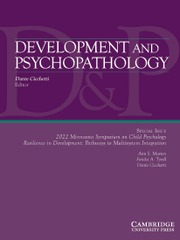Crossref Citations
This article has been cited by the following publications. This list is generated based on data provided by
Crossref.
Kerig, Patricia K.
and
Fedorowicz, Anne E.
1999.
Assessing Maltreatment of Children of Battered Women: Methodological and Ethical Considerations.
Child Maltreatment,
Vol. 4,
Issue. 2,
p.
103.
Feerick, Margaret M.
and
Haugaard, Jeffrey J.
1999.
Long-Term Effects of Witnessing Marital Violence for Women: The Contribution of Childhood Physical and Sexual Abuse.
Journal of Family Violence,
Vol. 14,
Issue. 4,
p.
377.
KAPLAN, SANDRA J.
PELCOVITZ, DAVID
and
LABRUNA, VICTOR
1999.
Child and Adolescent Abuse and Neglect Research: A Review of the Past 10 Years. Part I: Physical and Emotional Abuse and Neglect.
Journal of the American Academy of Child & Adolescent Psychiatry,
Vol. 38,
Issue. 10,
p.
1214.
Bagley, Christopher
and
Young, Loretta
1999.
Long-Term Evaluation of Group Counselling for Women with a History of Child Sexual Abuse: Focus on Depression, Self-Esteem, Suicidal Behaviors and Social Support.
Social Work with Groups,
Vol. 21,
Issue. 3,
p.
63.
Margolin, Gayla
and
Gordis, Elana B.
2000.
The Effects of Family and Community Violence on Children.
Annual Review of Psychology,
Vol. 51,
Issue. 1,
p.
445.
Suss, Amy L.
Homel, Peter
Hammerschlag, Margaret
and
Bromberg, Kenneth
2000.
Risk Factors for Pelvic Inflammatory Disease in Inner-City Adolescents.
Sexually Transmitted Diseases,
Vol. 27,
Issue. 5,
p.
289.
Fave, Antonella Delle
and
Massimini, Fausto
2000.
Living at home or in institution: adolescents' optimal experience and life theme building.
Paidéia (Ribeirão Preto),
Vol. 10,
Issue. 19,
p.
55.
Bagley, Christopher
and
Mallick, Kanka
2000.
Prediction of Sexual, Emotional, and Physical Maltreatment and Mental Health Outcomes in a Longitudinal Cohort of 290 Adolescent Women.
Child Maltreatment,
Vol. 5,
Issue. 3,
p.
218.
Muller, Robert T
Goebel-Fabbri, Ann E
Diamond, Terry
and
Dinklage, David
2000.
Social support and the relationship between family and community violence exposure and psychopathology among high risk adolescents.
Child Abuse & Neglect,
Vol. 24,
Issue. 4,
p.
449.
HAMARMAN, STEPHANIE
and
BERNET, WILLIAM
2000.
Evaluating and Reporting Emotional Abuse in Children: Parent-Based, Action-Based Focus Aids in Clinical Decision-Making.
Journal of the American Academy of Child & Adolescent Psychiatry,
Vol. 39,
Issue. 7,
p.
928.
Carrasco–Ortiz, Miguel Ángel
Rodrı́guez–Testal, Juan Francisco
and
Hesse, Blanca Mass
2001.
Problemas de conducta de una muestra de menores institucionalizados con antecedentes de maltrato.
Child Abuse & Neglect,
Vol. 25,
Issue. 6,
p.
819.
Jonson-Reid, Melissa
and
Way, Ineke
2001.
Adolescent sexual offenders: Incidence of childhood maltreatment, serious emotional disturbance, and prior offenses..
American Journal of Orthopsychiatry,
Vol. 71,
Issue. 1,
p.
120.
Higgins, Daryl J
and
McCabe, Marita P
2001.
Multiple forms of child abuse and neglect: adult retrospective reports.
Aggression and Violent Behavior,
Vol. 6,
Issue. 6,
p.
547.
FEHON, DWAIN C.
GRILO, CARLOS M.
and
LIPSCHITZ, DEBORAH S.
2001.
Gender Differences in Violence Exposure and Violence Risk among Adolescent Inpatients.
The Journal of Nervous and Mental Disease,
Vol. 189,
Issue. 8,
p.
532.
Odgers, CandiceL.
and
Moretti, MarleneM.
2002.
Aggressive and Antisocial Girls: Research Update and Challenges.
International Journal of Forensic Mental Health,
Vol. 1,
Issue. 2,
p.
103.
Hamarman, Stephanie
Pope, Kayla H.
and
Czaja, Sally J.
2002.
Emotional Abuse in Children: Variations in Legal Definitions and Rates Across the United States.
Child Maltreatment,
Vol. 7,
Issue. 4,
p.
303.
IRELAND, TIMOTHY O.
SMITH, CAROLYN A.
and
THORNBERRY, TERENCE P.
2002.
DEVELOPMENTAL ISSUES IN THE IMPACT OF CHILD MALTREATMENT ON LATER DELINQUENCY AND DRUG USE*.
Criminology,
Vol. 40,
Issue. 2,
p.
359.
Glaser, Danya
2002.
Emotional abuse and neglect (psychological maltreatment): a conceptual framework.
Child Abuse & Neglect,
Vol. 26,
Issue. 6-7,
p.
697.
Lee, Joseph K.P.
Jackson, Henry J.
Pattison, Pip
and
Ward, Tony
2002.
Developmental risk factors for sexual offending.
Child Abuse & Neglect,
Vol. 26,
Issue. 1,
p.
73.
Higgins, Daryl J.
2003.
The relationship of childhood family characteristics and current attachment styles to depression and depressive vulnerability.
Australian Journal of Psychology,
Vol. 55,
Issue. 1,
p.
9.

